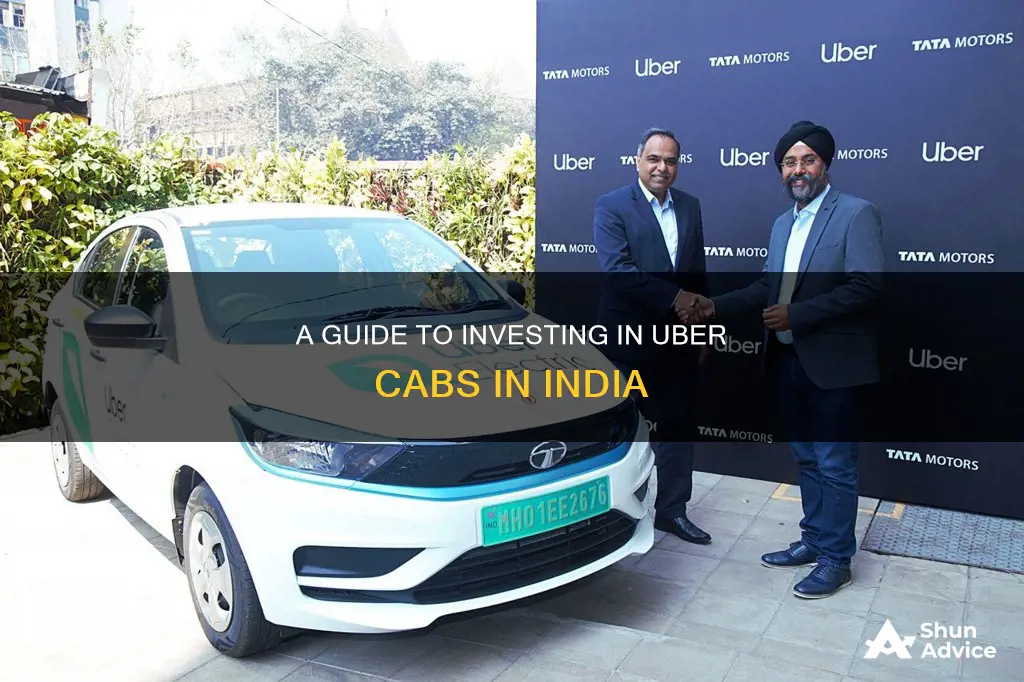
Uber is an American multinational transportation company that provides ride-hailing services, food delivery, and freight transport. It operates in approximately 70 countries and 10,500 cities worldwide, including India, where it has 5 million active riders. Uber has disrupted traditional taxicab businesses and offers a range of services, including Uber Intercity, which provides outstation cabs for intercity travel. In this paragraph, we will explore the topic of investing in Uber cabs in India, looking at the requirements, potential earnings, and the sign-up process.
What You'll Learn

Earn high IRRs by buying a car and partnering with Uber
Uber offers a unique opportunity to earn high IRRs of up to 20% by investing in a car and partnering with them. This option allows you to earn monthly revenues with a lower down payment. Here's a step-by-step guide to help you get started:
Step 1: Understand the Requirements
Before you invest in a car, it's important to understand the requirements to become an Uber partner. In India, you will need to convert your private car into a commercial vehicle, which typically takes 7 to 30 days and costs between Rs. 4,000 to Rs. 24,000. Additionally, you will need to meet the minimum requirements, which include vehicle registration and a driving license or photo ID.
Step 2: Explore Financing Options
Uber offers various financing options to help you get started. For example, in 2016, they offered a limited-period opportunity to get a car with a down payment as low as Rs. 27,000. Keep an eye out for similar offers or explore other financing options available in your city.
Step 3: Choose the Right Vehicle
When choosing a vehicle, consider your budget, earnings goals, and the type of opportunities you want to pursue. Uber has specific vehicle eligibility criteria, including age, make, model, and inspection requirements. You can visit Uber's website or a local Greenlight Hub to get more information on vehicle requirements.
Step 4: Sign up and Share Documents
To get started with Uber, sign up on their website and share the required documents, such as your driving license and vehicle registration. Uber will guide you through the process and help you activate your account.
Step 5: Activate Your Account
Once your documents are in order, bring your car to a local Greenlight Hub to activate your account. The requirements may vary by city, so be sure to check the specific guidelines for your location.
Step 6: Start Earning
Once your account is activated, you can start earning by driving with Uber. Remember to take advantage of Uber's various incentives and benefits, such as their Zero Emissions incentive for electric vehicles.
By following these steps, you can partner with Uber to earn high IRRs and build a successful business. Remember to stay updated with Uber's latest offerings and incentives to make the most of your partnership.
Smart Ways to Multiply Your 2000 INR Investment in India
You may want to see also

Requirements to sign up as a driver
To sign up as an Uber driver in India, you must meet several requirements. Firstly, you need to be at least 18 years old and have a valid driver's license, either private or commercial. You also need to provide proof of residency in your city, state, or province, such as a Pan Card.
In terms of vehicle requirements, you will need a commercial car with relevant documents, including commercial insurance, a vehicle registration certificate, and a permit. If you don't own a car, Uber can help you connect with vehicle partners or fleet partners to get access to a car.
Before you can activate your account, you must also pass a background screening and submit your documents and a photo. You can do this by visiting the nearest Partner Seva Kendra in your city.
It's important to note that requirements may vary by city, so it's recommended to sign up to see the specific information for your location. Additionally, if you plan to convert your private car into a commercial vehicle for Uber, the process can take around 7 to 30 days and cost between Rs. 4,000 to Rs. 24,000, depending on the city and car model.
Savings Surplus: Impact on Economy and Investment Opportunities
You may want to see also

How to convert your private car into a commercial vehicle
To convert your private car into a commercial vehicle in India, you will need to follow a few steps and meet certain requirements. Here is a detailed guide on how to do it:
Step 1: Understand the Requirements
Before you begin the conversion process, it is important to understand the requirements for converting a private car into a commercial vehicle in India. As per regulations, every Indian car that operates as a commercial vehicle must have a commercial license. Additionally, you will need to ensure that your vehicle meets the necessary standards and requirements for commercial use, which may include obtaining a fitness certificate.
Step 2: Gather the Necessary Documents
To convert your private car into a commercial vehicle, you will need to provide various documents. These typically include:
- Original Registration Certificate (RC) of the vehicle
- Vehicle's insurance certificate
- Pollution Under Control (PUC) certificate
- No Objection Certificate (NOC) from the financier if the vehicle was purchased on loan
- Identity and address proof, such as an Aadhaar card, PAN card, passport, Voter's ID, or utility bills
Step 3: Visit the Vahan Citizen Services Website
The next step is to initiate the conversion process by visiting the official Vahan Citizen Services website (www.vahan.parivahan.gov.in). This website allows you to apply for the conversion online.
Step 4: Follow the Online Process
Once you are on the website, follow these steps:
- Select "Vehicle-related services" under the "Online Services" menu.
- Choose the "Conversion of Vehicles" option.
- Enter the registration number and chassis number, and click on "Validate Registration."
- Click on "Proceed."
- On the next page, enter the Vehicle Registration number and click on "Proceed."
- From the dropdown menu under "Online Services," select "Conversion of Vehicle."
- A message box will appear, listing the scanned copies of the documents you need to upload. Click "Yes" to proceed.
- Enter the chassis number and mobile number, and click on "Generate OTP."
- Enter the OTP you receive on your mobile phone.
- Click on the "Show Details" button.
- Verify the owner's details that appear on the screen.
- Verify and edit insurance details if necessary.
- Enter vehicle conversion details, including the converted vehicle type, class, and category.
- Proceed to payment and complete the online transaction.
- Accept the terms and conditions and continue.
- Select your payment gateway and bank, and then proceed.
Step 5: Physical Examination and Final Steps
Note that, in some cases, you may be required to take your vehicle to the Regional Transport Office (RTO) for a physical examination. After completing the online process and any necessary physical inspections, your application for conversion will be processed.
Step 6: Update Insurance and Permits
In addition to converting your vehicle registration, you must also update your insurance policy to a commercial one. You will need to purchase a new insurance policy for the commercial vehicle, as the existing private insurance policy will not be valid. Contact your insurance provider or explore other options to obtain the appropriate commercial vehicle insurance.
Additionally, depending on your specific commercial use, you may require additional permits beyond the documents listed above. These permits vary based on the nature of your commercial operations.
Step 7: Sign Up with a Ride-Sharing Platform (Optional)
If you plan to use your commercial vehicle for ride-sharing services like Uber, you can sign up to drive with them. Uber offers opportunities for individuals to partner with the company and earn income by providing rides. You can choose your own hours and drive when you want.
To sign up with Uber, you will typically need to meet their specific requirements and provide necessary documents, which may include a valid driver's license, proof of residency, vehicle documents, and background verification.
Portfolio Gains: Is 5% Enough?
You may want to see also

How to add a vehicle to your Uber account
To add a vehicle to your Uber account, follow these steps:
Through the Uber App:
- Click on your profile photo in the top right corner.
- Select "Account" from the dropdown menu.
- Tap "Vehicles" and then "Add Vehicle".
- You'll be directed to your Partner Portal, where you can enter your new vehicle's details.
Through a Web Browser:
- Go to partners.uber.com.
- Log in to your account.
- Choose "Vehicles" from the menu.
- Click on "Add a new vehicle" and follow the prompts.
- Upload clear, readable photos of your vehicle's documents.
After submitting your vehicle information and documents, Uber will review them. Once approved, your vehicle will be activated for use on the Uber platform.
Savings and Investments: Smart Money Strategies for Beginners
You may want to see also

Pros and cons of investing in Uber cabs
Pros of Investing in Uber Cabs
- Uber cabs are in high demand due to heavy urban traffic, parking hassles, late-night parties, and responsible drinking.
- Uber offers quality, price, security, and trust, which has helped it gain a loyal customer base.
- Uber cabs provide an opportunity to be your own boss, with flexible working hours and the potential to earn extra income.
- Uber helps find a driver for those who want to put their car to use but don't want to drive.
- Uber offers weekly automated payments straight to your account, with potential returns of up to 20% IRR.
Cons of Investing in Uber Cabs
- The conversion process of a private car into an Uber cab can take 7-20 days and cost between ₹4000-₹24000.
- Uber takes a 20% commission, which can impact the overall earnings of drivers.
- Uber's "surge pricing" can lead to unpredictable and higher prices during busy times, which may be a turn-off for customers.
- The gig economy nature of Uber's business model has been controversial, with drivers not guaranteed a minimum wage, having to supply and maintain their vehicles, and often struggling to earn a decent income after Uber's cut.
- Increased competition from other ride-sharing services and a continuous influx of new drivers push average earnings downward, requiring longer working hours to maintain income.
Is the CIMA Exam a Challenge?
You may want to see also
Frequently asked questions
You can invest in Uber cabs in India by partnering with Uber. You can convert your private car into a commercial vehicle and sign up to drive with Uber. You can also find a driver for your car through Uber.
The requirements to become an Uber driver in India include: being at least 18 years old, having a valid driver's license (private or commercial), clearing a background screening, and providing proof of residency in your city, state, or province. You will also need to submit documents such as an Aadhar card, PAN card, vehicle insurance, vehicle registration certificate, and permit.
As an Uber driver in India, your earnings will depend on the fare minus the Uber fee and service tax. Uber takes a 20% commission on each ride. There are also bonus incentives and surge pricing opportunities that can increase your earnings.
Investing in Uber cabs in India can provide you with a good side hustle or even a full-time income. It offers flexible working hours, the opportunity to be your own boss, and the ability to earn extra money by driving during your free time. Additionally, partnering with a well-known brand like Uber can provide you with global reach and recognition.







